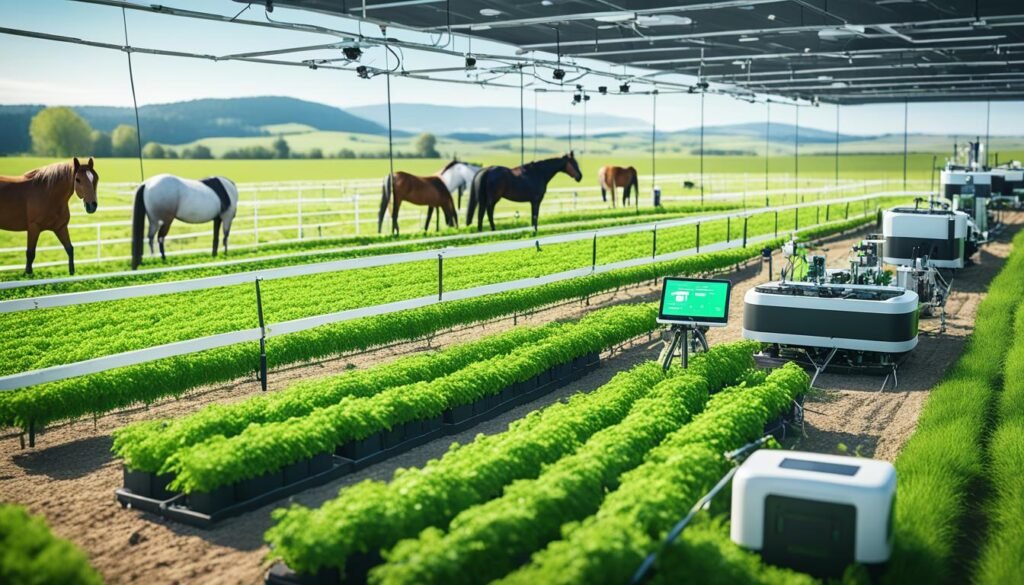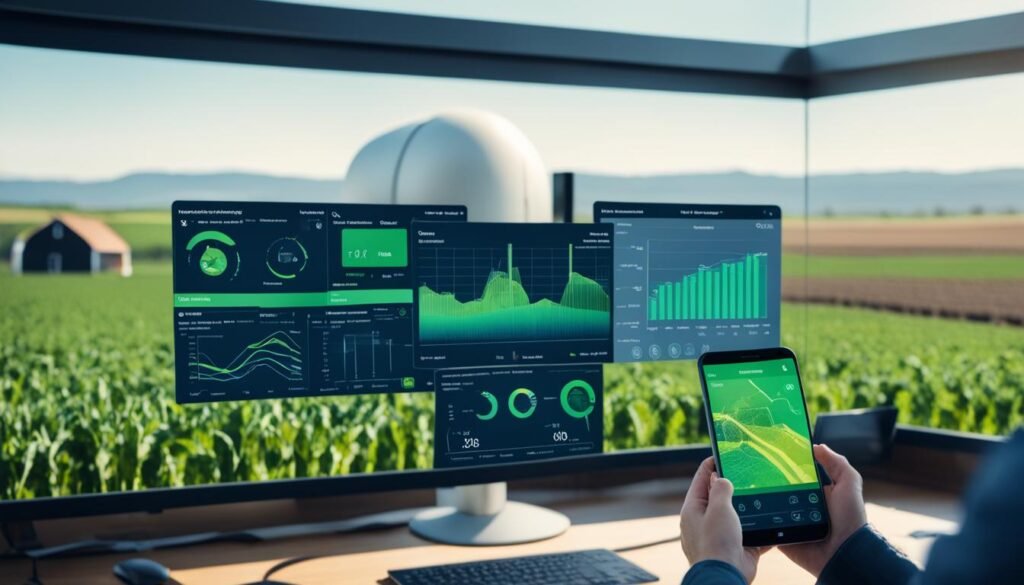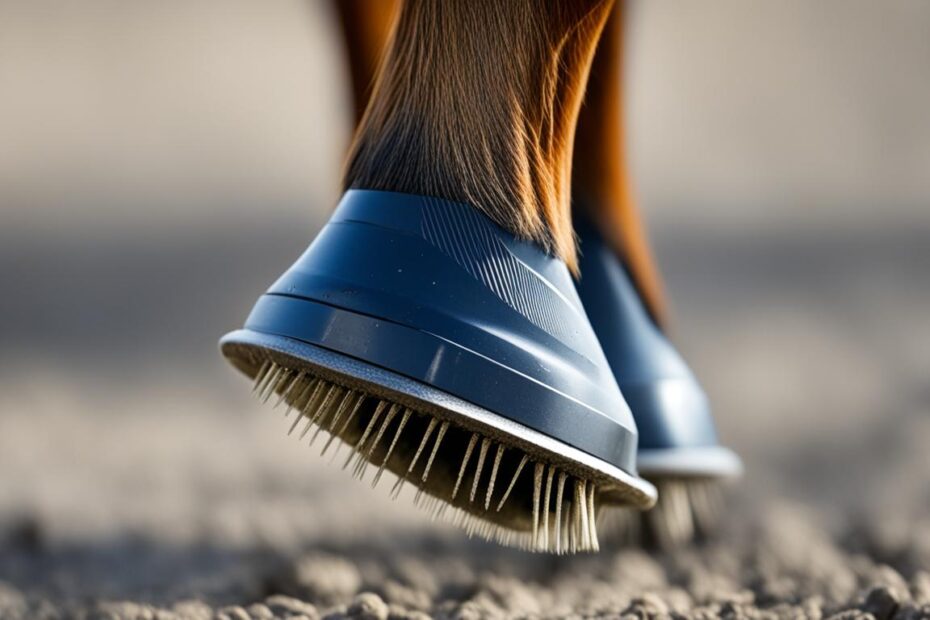In the ever-evolving landscape of agriculture, a remarkable intersection of technology and animal science is transforming the way we approach precision farming.
The integration of nano-sensors into horse hooves is revolutionizing the way farmers monitor their livestock and optimize their operations. This innovative approach not only enhances agricultural productivity but also prioritizes animal welfare and promotes sustainable farming practices.
By harnessing the power of nanotechnology, scientists are developing cutting-edge solutions that unlock new possibilities for the agriculture industry. These nano-sensors, embedded within the equine hoof structure, provide real-time data on various aspects of animal health, movement, and environmental conditions, enabling farmers to make informed decisions and optimize their farming practices.
From monitoring the biomechanics of horse hooves to leveraging the Internet of Things (IoT) for precision livestock farming, this article delves into the exciting advancements that are redefining the future of agriculture.
Explore the potential of wearable sensors for animal health monitoring, the benefits of data-driven decision-making, and the holistic approach to sustainable agriculture practices.
As we navigate the evolving landscape of precision farming, the integration of nano-sensors in horse hooves stands as a testament to the transformative power of technology and its ability to enhance the agriculture industry’s productivity, animal welfare, and environmental stewardship.
Nanotechnology in Agriculture: A Game-Changer
The world of agriculture is undergoing a remarkable transformation, thanks to the emergence of nanotechnology. This innovative technology is revolutionizing the way we approach precision farming and sustainable agricultural practices.
At the heart of this revolution are nano-sensors, microscopic devices capable of monitoring a wide range of environmental and biological factors with unparalleled accuracy.
Exploring the Potential of Nano-Sensors
Nano-sensors have the ability to collect and transmit real-time data on soil composition, moisture levels, nutrient availability, and even the health and behavior of livestock.
This precise and timely information empowers farmers to make informed, data-driven decisions that optimize resource allocation, enhance productivity, and minimize environmental impact.
The integration of nano-sensors with the Internet of Things (IoT) further amplifies the potential of precision farming, paving the way for smart farming solutions that harness the power of connected devices and data analytics.
Challenges and Opportunities in Nanotech Farming
While the potential of nanotechnology in agriculture is undeniable, the integration of this transformative technology is not without its challenges.
Concerns around the safety and environmental impact of nano-materials, as well as the need for robust regulatory frameworks, must be carefully addressed. Nevertheless, the opportunities presented by nanotech farming are vast and compelling.
By harnessing the power of nano-sensors, farmers can unlock new levels of precision, efficiency, and sustainability, ultimately driving a more resilient and future-proof agricultural landscape.
Equine Biomechanics: Understanding Horse Hooves
To fully appreciate the impact of nano-sensors in horse hooves, it is essential to have a comprehensive understanding of equine biomechanics.
The intricate structure and function of a horse’s hoof are the foundation for how these innovative technologies can enhance precision livestock farming and animal health monitoring.
The horse’s hoof is a complex and remarkable structure, composed of various layers and tissues that work together to provide support, traction, and shock absorption.
At the core of the hoof is the coffin bone, surrounded by the sensitive laminae, which connect the bone to the tough, protective outer wall. This delicate balance of rigidity and flexibility allows horses to navigate various terrains with ease and comfort.
Understanding the biomechanics of equine hooves is crucial for maintaining optimal hoof health and preventing common issues like laminitis, sole bruising, and hoof cracks.
By monitoring the hoof’s structure and function using nano-sensors, farmers can detect potential problems early and intervene with targeted treatments, ultimately improving the overall well-being and performance of their horses.
| Key Equine Hoof Structures | Function |
|---|---|
| Coffin Bone | Provides structural support and shock absorption |
| Sensitive Laminae | Connects the coffin bone to the hoof wall |
| Hoof Wall | Tough, protective outer layer that provides traction and stability |
By leveraging the insights gained from equine biomechanics, farmers can utilize nano-sensors in horse hooves to monitor key parameters, such as hoof temperature, pressure distribution, and gait patterns. This data can then be analyzed to identify early warning signs of potential health issues, allowing for proactive intervention and improved animal welfare.
Integrating this knowledge of horse hoof biomechanics with the power of nano-sensors and precision livestock farming technology is a game-changer, empowering farmers to make data-driven decisions that enhance the health, productivity, and overall well-being of their equine herds.
Smart Farming: Harnessing the Internet of Things (IoT)
The integration of the Internet of Things (IoT) into agriculture has ushered in a new era of smart farming, transforming the way farmers approach precision livestock management and sustainable decision-making.
IoT-enabled technologies, such as wearable sensors and cloud-based analytics, are empowering farmers to monitor and optimize their operations like never before.
IoT-Enabled Precision Livestock Farming
Smart farming leverages the power of IoT to provide farmers with real-time data on their livestock. Wearable sensors attached to animals can track vital signs, movement patterns, and environmental conditions, offering valuable insights into the health and well-being of the herd.
By analyzing this data through advanced analytics, farmers can make more informed decisions, optimizing feed and medication, and proactively addressing any potential issues.
Data-Driven Decision Making for Sustainable Agriculture
The wealth of data generated by IoT-enabled smart farming technologies is transforming the way farmers approach sustainability.
With access to detailed information on herd health, feed consumption, and environmental factors, farmers can make data-driven decisions to improve productivity while minimizing their environmental impact. This data-driven approach to precision livestock farming is a key driver in the pursuit of sustainable agriculture practices.

By embracing the power of IoT, farmers are ushering in a new era of smart, sustainable, and data-driven agriculture.
As the technology continues to evolve, the potential for IoT-powered precision livestock farming and data-driven decision-making is poised to revolutionize the future of sustainable food production.
Wearable Sensors for Animals: A New Frontier
The advancements in wearable sensor technology have revolutionized the field of precision livestock farming. By equipping animals, including horses, with these cutting-edge devices, farmers can now closely monitor their health, behavior, and environmental conditions, leading to improved animal welfare and more efficient farming operations.
Monitoring Animal Health and Behavior
Wearable sensors for animals, such as accelerometers, GPS trackers, and biometric sensors, provide farmers with a wealth of real-time data. This data allows them to track an animal’s movements, activity levels, and even physiological indicators like heart rate and body temperature.
By analyzing this information, farmers can detect early signs of illness, injury, or stress, enabling them to intervene promptly and provide the necessary care.
Moreover, these wearable sensors can shed light on an animal’s natural behaviors, such as grazing patterns, social interactions, and sleep cycles.
This invaluable data can help farmers optimize their management practices, ensuring the animals’ well-being and improving overall herd productivity in precision livestock farming.
| Sensor Type | Monitored Parameters | Potential Applications |
|---|---|---|
| Accelerometer | Movement, activity levels | Early detection of lameness, monitoring of behavioral patterns |
| GPS Tracker | Location, movement patterns | Livestock tracking, pasture management, grazing behavior analysis |
| Biometric Sensor | Heart rate, body temperature, respiration rate | Animal health monitoring, early illness detection, stress management |
The integration of these wearable sensors for animals into precision farming practices has opened up new frontiers in animal health monitoring and herd management.
By harnessing the power of data-driven insights, farmers can make more informed decisions, optimize resource allocation, and ultimately enhance the overall welfare and productivity of their equines and other livestock.
Creating Nano-Sensors in Horse Hooves for Precision Farming
In the realm of precision farming, the integration of advanced technologies like nanotechnology is revolutionizing the way we monitor and care for livestock. One such innovative development is the creation of nano-sensors that can be embedded within horse hooves, unlocking a new frontier in equine biomechanics and animal health monitoring.
Through meticulous research and engineering breakthroughs, scientists have devised a process to seamlessly incorporate these micro-devices into the complex structure of horse hooves.
These nano-sensors are designed to capture a wide range of data, from gait analysis and ground reaction forces to environmental conditions, all with the goal of enhancing precision livestock farming and improving animal welfare.
By closely monitoring the biomechanics of horse hooves, farmers can gain invaluable insights into the overall health and well-being of their animals. This data-driven approach enables them to make more informed decisions, detect potential issues early, and proactively address any concerns, ultimately leading to better herd management and increased productivity.
Furthermore, the integration of these nano-sensors extends beyond the individual animal, as the collected data can be integrated into broader precision farming initiatives.
By leveraging the power of the Internet of Things (IoT) and data analytics, farmers can optimize resource allocation, tailor feed and medication regimens, and make strategic decisions that promote sustainable and efficient agricultural practices.
As the field of precision farming continues to evolve, the creation of nano-sensors in horse hooves represents a significant step forward.
By harnessing the potential of these innovative technologies, farmers can enhance animal health monitoring, optimize resource utilization, and drive sustainable agricultural practices, ultimately contributing to the overall well-being of their livestock and the environment.
Precision Livestock Farming: Benefits and Applications
In the realm of modern agriculture, precision livestock farming has emerged as a game-changing approach. Enabled by technologies like nano-sensors in horse hooves, this innovative practice offers a wide range of benefits that extend beyond mere productivity improvements.
At the heart of precision livestock farming lies a focus on enhancing animal welfare and promoting sustainable agriculture practices.
Improving Animal Welfare and Productivity
The integration of nano-sensors in horse hooves allows for unprecedented monitoring of animal health, behavior, and well-being.
By providing real-time data on parameters such as gait, stress levels, and overall physiological indicators, these sensors enable farmers to identify and address any issues promptly. This proactive approach not only enhances the comfort and well-being of the animals but also leads to improved productivity and resource efficiency.
- Early detection of health problems and timely interventions
- Optimization of feeding and housing conditions for animal comfort
- Reduced risk of injuries and minimized need for medication
Moreover, the data generated by these nano-sensors can be used to make informed decisions regarding breeding, herd management, and overall resource allocation. This data-driven approach ensures that farmers can maximize the productivity and welfare of their livestock, ultimately contributing to the sustainability of their agricultural practices.
| Benefit | Impact |
|---|---|
| Improved animal welfare | Reduced stress, fewer injuries, and enhanced comfort for the animals |
| Increased productivity | Higher yields, better resource utilization, and more efficient operations |
| Sustainable agriculture practices | Reduced environmental impact, better resource management, and long-term viability |
By harnessing the power of precision livestock farming, farmers can strike a harmonious balance between animal welfare, productivity, and sustainable agriculture practices.
This holistic approach not only benefits the animals but also contributes to the overall resilience and profitability of the farming operation.
Equine Health and Wellness: Empowering Farmers
The integration of nano-sensors into horse hooves marks a significant breakthrough in the world of precision livestock farming. By harnessing this advanced technology, farmers can now gain unprecedented insights into the health and well-being of their equine livestock.
This transformative development empowers farmers to proactively monitor and address equine health concerns, leading to improved animal welfare and more sustainable agriculture practices.
One of the key advantages of this nano-sensor technology is its ability to provide real-time data on various aspects of equine health. Farmers can now closely track their horses’ movement patterns, vital signs, and overall physical condition, enabling them to identify and address potential issues before they escalate.
This early detection and intervention can significantly enhance the overall health and productivity of the herd, ultimately contributing to a more sustainable and profitable farming operation.
| Metric | Benefits of Nano-Sensor Monitoring |
|---|---|
| Hoof Health | Early detection of lameness, inflammation, and other hoof-related issues |
| Respiratory Health | Monitoring for signs of respiratory distress or infection |
| Activity Levels | Identifying changes in behavior that may indicate illness or injury |
| Vital Signs | Continuous monitoring of heart rate, body temperature, and other critical indicators |
By leveraging the data collected by these nano-sensors, farmers can make more informed decisions regarding their animals’ care and management. This data-driven approach not only enhances animal welfare but also contributes to the overall sustainability of the farming operation.
Farmers can optimize their feeding and breeding programs, reduce the use of antibiotics and other medications, and minimize the environmental impact of their activities, all while maintaining the health and productivity of their equine herd.
The integration of nano-sensors into horse hooves represents a significant leap forward in the field of precision livestock farming. By empowering farmers with real-time insights into the health and well-being of their animals, this technology is poised to transform the way we approach equine management and contribute to the broader goals of sustainable agriculture.
Sustainable Agriculture Practices: A Holistic Approach
As precision farming technologies, including nano-sensors in horse hooves, continue to evolve, they are paving the way for a more sustainable and holistic approach to agriculture.
Farmers are now able to strike a delicate balance between maximizing productivity and ensuring environmental stewardship, ultimately contributing to the long-term viability of agricultural systems.
Balancing Productivity and Environmental Stewardship
The integration of data-driven farming decisions, enabled by cutting-edge technologies, has empowered farmers to optimize their operations for both productivity and environmental preservation.
By closely monitoring soil health, crop yields, and animal welfare through precise sensor data, farmers can make informed choices that enhance their bottom line while also minimizing the ecological footprint of their practices.
For example, the use of nano-sensors in horse hooves can provide real-time insights into the animals’ biomechanics and overall well-being. This allows farmers to tailor their livestock management strategies, ensuring optimal animal health and welfare, which in turn boosts productivity and reduces the environmental impact of their operations.
Moreover, the data collected from these advanced technologies can inform sustainable agriculture practices, such as precision irrigation, targeted fertilizer application, and efficient resource management.
By making data-driven decisions, farmers can enhance their productivity while simultaneously promoting environmental stewardship and preserving the long-term viability of their land.
- Optimize operations for both productivity and environmental preservation
- Leverage data-driven insights to make informed choices
- Adopt sustainable agriculture practices to enhance productivity and reduce ecological impact
As the agricultural industry continues to evolve, the integration of precision farming technologies and a holistic approach to sustainability will be crucial in meeting the growing demand for food production while safeguarding the environment for future generations.
Data-Driven Insights: Unlocking the Potential
The wealth of data generated by nano-sensors in horse hooves and other precision farming technologies unlocks a world of data-driven insights.
Farmers can now leverage advanced analytics to make more informed, strategic decisions that optimize animal welfare, productivity, and the overall sustainability of their farming operations.
Leveraging Analytics for Smarter Farming Decisions
The integration of smart farming technologies, such as precision livestock farming and data-driven farming decisions, has revolutionized the way farmers approach their operations.
By harnessing the power of data analytics, farmers can now gain a deeper understanding of their animals’ health, behavior, and environmental conditions, ultimately leading to more efficient and sustainable agriculture practices.
Through the analysis of real-time data from nano-sensors, farmers can make more informed decisions regarding animal feeding, housing, and healthcare, ensuring the well-being of their livestock.
Additionally, data-driven insights can help optimize resource allocation, reduce waste, and enhance overall productivity, contributing to the long-term viability of the farm.
Moreover, the implementation of smart farming practices, including the use of precision livestock farming technologies, aligns with the growing demand for sustainable agriculture. By leveraging data-driven insights, farmers can make more environmentally conscious choices, reducing their carbon footprint and promoting the preservation of natural resources.

As the agricultural industry continues to evolve, the integration of data-driven farming decisions and precision livestock farming will become increasingly crucial. By embracing these innovative technologies, farmers can unlock the full potential of their operations, driving towards a future of smart, sustainable, and data-driven agriculture.
The Future of Precision Farming: Trends and Innovations
As the integration of nano-sensors in horse hooves continues to evolve, the future of precision farming holds immense promise. From advancements in nanotechnology to the widespread adoption of smart farming practices, the agricultural landscape is undergoing a transformative shift, driven by innovative technologies and sustainable approaches.
One of the key trends shaping the future of precision farming is the growing integration of nanotechnology in agriculture. Nano-sensors embedded in horse hooves, for instance, are enabling farmers to gather real-time data on animal health, movement, and environmental conditions, revolutionizing the way they manage their livestock and optimize their operations.
Alongside the advancements in nano-sensors, the Internet of Things (IoT) is rapidly transforming the way farmers approach their work. IoT-enabled precision livestock farming allows for the continuous monitoring of animal health and behavior, empowering farmers to make data-driven decisions that enhance animal welfare, productivity, and overall sustainability.
As the industry continues to embrace these cutting-edge technologies, the focus on sustainable agriculture practices is also gaining momentum.
Farmers are increasingly adopting holistic approaches that balance productivity with environmental stewardship, leveraging data-driven insights to optimize resource use, reduce waste, and minimize the environmental impact of their operations.
The future of precision farming is indeed an exciting frontier, with a myriad of trends and innovations poised to revolutionize the way we approach food production. From nano-sensors to smart farming, the potential for transformative change is vast, promising a more sustainable, efficient, and data-driven agricultural landscape for years to come.
Conclusion
In conclusion, the integration of nano-sensors into horse hooves marks a groundbreaking advancement in precision farming. By harnessing the power of nanotechnology, scientists and farmers are revolutionizing the way we approach agricultural practices, prioritizing animal welfare, productivity, and environmental sustainability.
As this technology continues to evolve, the future of precision farming holds exciting possibilities for transforming the industry and meeting the growing global demand for food in a responsible and innovative manner.
The implementation of nano-sensors in horse hooves enables real-time monitoring of animal health, behavior, and biomechanics, providing farmers with invaluable data-driven insights.
This technology not only improves animal welfare but also enhances productivity and efficiency, aligning with the principles of smart farming and precision livestock farming.
By leveraging the Internet of Things (IoT) and data analytics, farmers can make more informed decisions, optimizing resource utilization and minimizing the environmental impact of their operations.
Moreover, the integration of nanotechnology in agriculture showcases the potential of sustainable agriculture practices. By combining technological advancements with a holistic approach to farming, we can strike a balance between maximizing productivity and preserving the delicate ecosystem.
As the industry continues to evolve, the future of precision farming holds promise for a more food-secure and environmentally-conscious future.
FAQ
What is the purpose of integrating nano-sensors into horse hooves for precision farming?
The integration of nano-sensors into horse hooves is a revolutionary approach to precision farming. These microscopic devices can precisely monitor a wide range of environmental and biological factors, enabling farmers to enhance agricultural productivity, animal welfare, and sustainable farming practices.
How does nanotechnology benefit the agriculture industry?
Nanotechnology has emerged as a game-changer in the world of agriculture, offering new possibilities for precision farming and sustainable practices.
Nano-sensors can monitor a wide range of environmental and biological factors with unprecedented accuracy, leading to data-driven decision making and more efficient farming operations.
Why is understanding equine biomechanics important for the integration of nano-sensors in horse hooves?
To fully appreciate the impact of nano-sensors in horse hooves, it is essential to understand the complex biomechanics of equine feet.
This knowledge can be leveraged to enhance precision livestock farming and animal health monitoring, ultimately leading to improved welfare and productivity.
How does the Internet of Things (IoT) contribute to smart farming and precision livestock farming?
The integration of the Internet of Things (IoT) into farming has ushered in a new era of smart agriculture, enabling precision livestock farming and data-driven decision making. IoT-enabled technologies, such as wearable sensors and cloud-based analytics, are transforming the way farmers monitor and manage their herds, leading to more sustainable and productive agricultural practices.
What are the benefits of using wearable sensors for animals in precision farming?
The development of wearable sensors for animals has opened up a new frontier in precision farming. By equipping livestock, including horses, with these advanced devices, farmers can now closely monitor their health, behavior, and environmental conditions, leading to improved animal welfare and more efficient farming operations.
How are nano-sensors created and integrated into horse hooves for precision farming?
The process of creating nano-sensors that can be integrated into horse hooves involves innovative research and technological advancements. These micro-devices can precisely monitor various parameters, from gait analysis to environmental conditions, to enhance precision farming and animal welfare.
What are the key benefits of precision livestock farming?
Precision livestock farming, enabled by technologies like nano-sensors in horse hooves, offers a wide range of benefits. It can improve animal welfare, enhance productivity, and contribute to the overall sustainability of agricultural practices, ultimately leading to more efficient and responsible farming.
How can nano-sensors in horse hooves empower farmers to improve equine health and wellness?
By integrating nano-sensors into horse hooves, farmers gain unprecedented insights into the health and wellbeing of their equine livestock. This technology empowers farmers to proactively monitor and address equine health concerns, leading to improved animal welfare and more sustainable farming practices.
How can precision farming technologies help achieve a balance between productivity and environmental stewardship?
Precision farming technologies, including nano-sensors in horse hooves, are paving the way for a more sustainable and holistic approach to agriculture. These advancements enable farmers to strike a balance between productivity and environmental stewardship, ultimately contributing to the long-term viability of agricultural systems.

